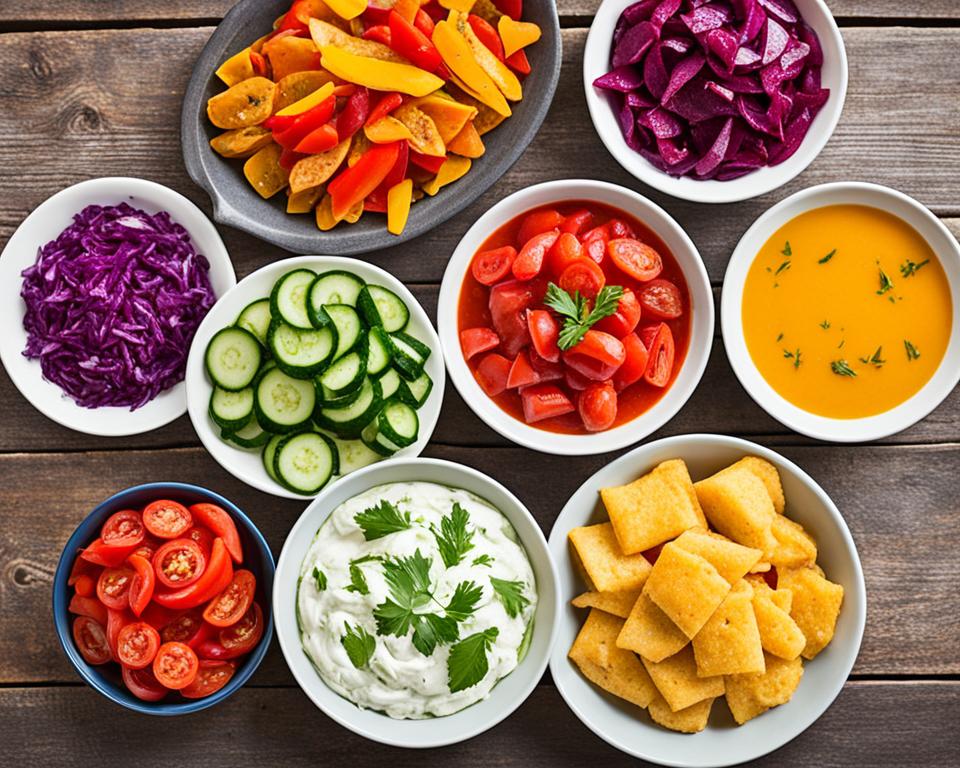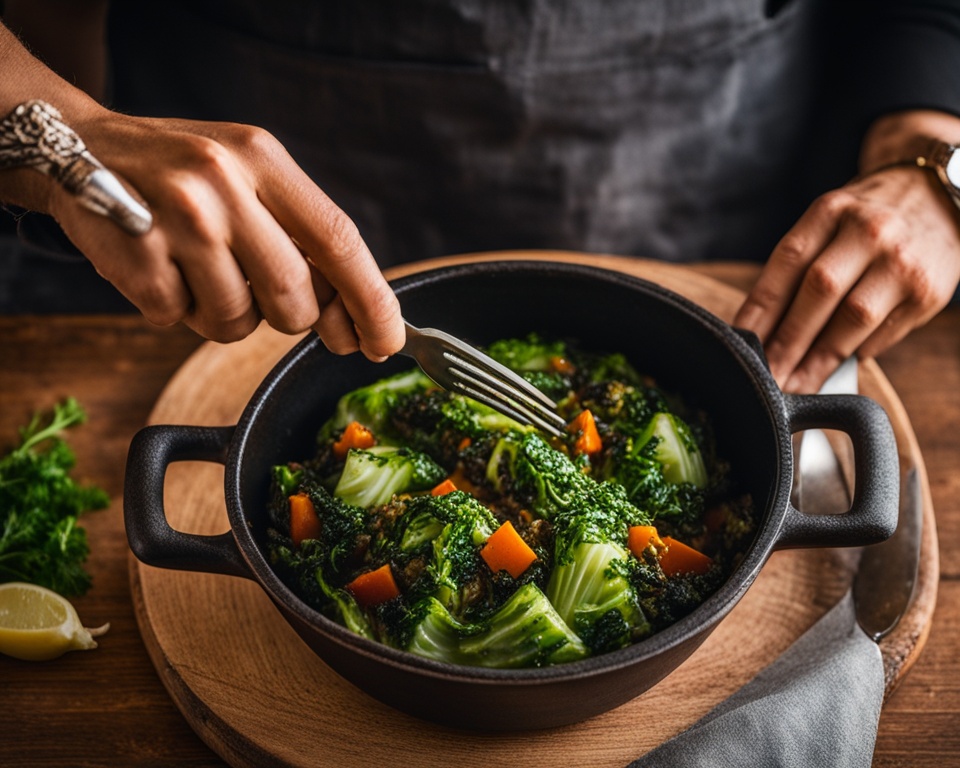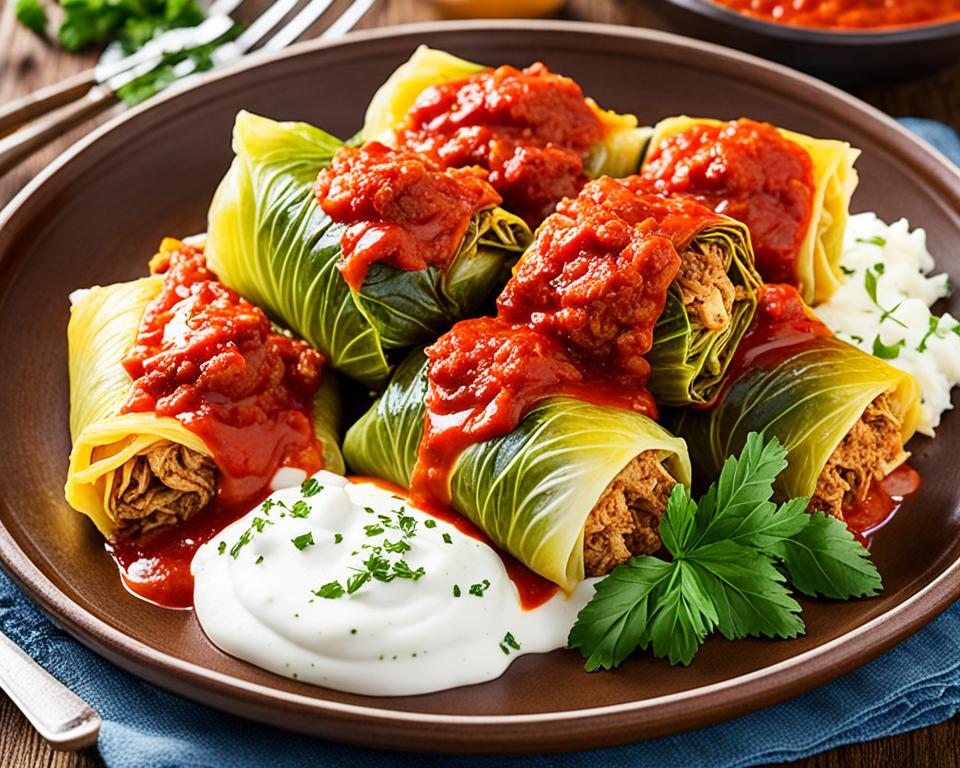Sarmale, a favorite in Romania, are stuffed cabbage rolls that are deeply rooted in the country’s food culture. They have been a mainstay in Romanian kitchens for many years. These rolls are not just food; they are a way to connect with family and tradition.
When you smell sarmale cooking, it takes you back to happy times. It reminds you of family meals and celebrations. This dish is more than food; it’s a way to share love and togetherness.
Read interesting things at : warlockgroup
Key Takeaways
- Sarmale are a traditional Romanian dish of stuffed cabbage rolls
- The dish is a beloved comfort food and a symbol of family traditions in Romania
- Sarmale have been a staple in Romanian homes for generations
- The dish is often served at family gatherings, bringing people together
- Sarmale are a reflection of Romania’s rich culinary heritage
Discovering the Culinary Heritage of Romanian Sarmale
Romanian cuisine is full of flavors, traditions, and cultural influences. Sarmale, the stuffed cabbage rolls, show us this rich heritage. This dish has been passed down for generations, keeping its core essence as a beloved comfort food in Romanian cuisine.
Sarmale are more than a traditional eastern european food. They show the creativity and resourcefulness of the Romanian people. These rolls are made with care, filled with minced meat, rice, and spices. The cabbage leaves wrap around the filling, showing the depth of traditional recipe developed over centuries.
“Sarmale are not just a dish, but a living embodiment of Romania’s cultural significance.”
Making sarmale is a labor of love, bringing families and communities together. It preserves the traditions that have made this dish a key part of romanian cuisine. From rolling the cabbage leaves to simmering the sarmale in broth, each step shows the care passed down through generations.
When you take your first bite of sarmale, you’re not just tasting a dish. You’re going on a culinary journey that connects to Romanian heritage. The flavors of the past and present come together, making a memorable food experience.
What are Sarmale?
Sarmale are a traditional Romanian dish. They are made by stuffing cabbage leaves with a tasty filling. This dish is a key part of Romania’s culinary culture.
The cabbage leaves are soft and delicate. They wrap around a filling of ground meat. This filling is rich and flavorful.
Unpacking the Flavors of Romania’s Beloved Dish
The filling of sarmale is a mix of ground meat, rice, onions, and spices. These ingredients blend together to create a unique taste. The meat is rich, and the rice adds a bit of texture.
The cabbage leaves add a touch of sweetness. This balances out the savory meat perfectly. It makes each bite a burst of flavor.
| Key Ingredients | Flavor Profile |
|---|---|
|
|
The unique taste of sarmale shows the skill of Romanian cooks. They have made this dish over many years. Every part of it, from the leaves to the filling, captures Romanian flavors.
The Origins of Sarmale in Romanian Cuisine
The history of sarmale, Romania’s favorite stuffed cabbage rolls, goes way back. It comes from the mix of culinary traditions that have shaped Romanian food over the years. Thanks to its location and cultural exchanges, sarmale have grown from old recipes and methods. They mix local ingredients with flavors from around the world.
Sarmale started from the Romanian culinary traditions. These traditions were influenced by being close to Eastern European cuisine. Romania has always been a place where different cultures meet. Sarmale is a great example of this mix of flavors.
The dish might have started with the stuffed grape leaves from the Mediterranean. These were then adapted using the cabbage that grows a lot in Romania. Cooks added local spices, meats, and grains to make sarmale taste unique today.
| Key Influences on the Origins of Sarmale | Impact on the Dish |
|---|---|
| Mediterranean Stuffed Grape Leaf Dishes | Inspired the basic concept of stuffed rolls |
| Abundant Cabbage Crops in Romania | Led to the use of cabbage leaves as the primary wrapper |
| Regional Spices and Ingredients | Contributed to the unique flavor profile of Romanian sarmale |
The story of sarmale shows the rich history of Romanian culinary traditions. These traditions blend old methods with flavors from around the world. Sarmale is a dish that shows Romania’s cultural heritage. It’s a beloved part of Eastern European cuisine and a symbol of Romania’s culinary past.
Classic Sarmale Recipe
Sarmale is a beloved traditional Romanian dish. It’s a labor of love that requires careful preparation and attention to detail. The classic sarmale recipe blends the flavors of tender cabbage leaves, savory ground meat, and aromatic seasonings.
Ingredients and Preparation
To make perfect sarmale, you need a list of ingredients and a step-by-step guide. This ensures the traditional preparation is done with precision.
- Get a fresh, medium-sized head of green cabbage and remove the outer leaves. Keep them for wrapping.
- In a large bowl, mix ground pork and beef with rice, onions, garlic, dill, salt, and pepper. This makes the filling.
- Put a spoonful of filling in the center of each cabbage leaf. Then, roll and secure the leaf around the filling.
- Put the rolled cabbage in a large pot. Layer them with sauerkraut, smoked pork, and tomato sauce.
- Cover the pot and simmer the sarmale over low heat for 2-3 hours. This lets the flavors mix and the cabbage get tender.
The result is a dish that shows off Romania’s traditional preparation and rich culinary heritage. Sarmale is a labor of love, deeply valued in the country’s culture.
| Ingredient | Quantity |
|---|---|
| Green Cabbage | 1 medium-sized head |
| Ground Pork | 1 lb |
| Ground Beef | 1 lb |
| Rice | 1 cup |
| Onions, diced | 2 medium |
| Garlic, minced | 3 cloves |
| Dill | 2 tbsp, chopped |
| Salt | to taste |
| Black Pepper | to taste |
| Sauerkraut | 1 cup |
| Smoked Pork | 1 lb, chopped |
| Tomato Sauce | 1 cup |
Sarmale: A Comforting Taste of Eastern European Tradition
Sarmale, the beloved stuffed cabbage rolls of Romanian cuisine, are more than just food. They are a symbol of Eastern European culinary tradition. They bring comfort to many families.
The smell of sarmale cooking brings back memories of warmth and connection to our cultural roots. For generations, sarmale have been a key part of Romanian meals. They show the rich flavors and textures of the region.
Sarmale are a comfort food that brings people together. They remind us of happy times with family and friends. Making these dishes is often a family affair, creating a sense of unity.
“Sarmale are more than just a dish – they are a thread that binds generations, a taste of home that nourishes the soul.”
Sarmale are popular because they connect us to our cultural heritage. They symbolize family and community. These stuffed cabbage rolls are a beloved part of Eastern European cuisine, offering a taste of tradition that lasts through time.
Variations on the Traditional Sarmale
The classic sarmale recipe is still a staple in Romanian cuisine. Over time, it has taken on new twists and modern adaptations. These changes highlight the creativity and versatility in Romanian cooking.
Regional Recipes and Unique Flavors
Across Romania, sarmale recipes vary by region. In Transylvania, they mix pork and beef with paprika and caraway seeds. Moldavia’s version includes rice, lamb, and herbs.
In Dobrogea, seafood sarmale are popular. They use fish and shellfish in the filling.
Contemporary Sarmale Adaptations
Modern chefs have put their spin on sarmale. They use grape leaves or savoy cabbage instead of traditional cabbage. Some even make vegetarian or vegan versions with tofu or mushrooms.
This makes sarmale more appealing to different tastes and diets.
| Regional Sarmale Variations | Key Ingredients |
|---|---|
| Transylvanian Sarmale | Pork, beef, paprika, caraway seeds |
| Moldavian Sarmale | Lamb, rice, aromatic herbs |
| Dobrogea Seafood Sarmale | Fish, shellfish |
| Vegetarian/Vegan Sarmale | Tofu, mushrooms |
These sarmale variations show Romania’s rich culinary diversity. They prove the lasting popularity of this national dish.
The Sarmale Ritual: Bringing Families Together
The making and eating of sarmale, Romania’s favorite stuffed cabbage rolls, is a big part of the country’s culture. Families come together to roll the cabbage leaves and share stories. This makes the dish a special way to connect.
The sarmale tradition is more than cooking. It’s a way to bring different generations together. They learn the recipes and techniques from each other, keeping the tradition alive.
Preparing sarmale takes a lot of love and care. It needs patience and a love for the flavors and textures. Rolling the cabbage leaves and making the filling is a tradition that goes beyond just eating. It’s about celebrating family, community, and Romanian food culture.
“Sarmale is not just a dish; it’s a tapestry of memories, traditions, and the unbreakable bonds that hold our families together.”
When the sarmale cook, their smell fills the house. It brings everyone to the table to enjoy this shared moment. Whether it’s for a holiday, Sunday dinner, or a special event, sarmale shows the strength of family traditions and the importance of this Romanian dish.
Sarmale: A Labor of Love
Making sarmale, the beloved Romanian stuffed cabbage rolls, takes a lot of time and effort. It requires patience, skill, and a love for the culinary tradition. From picking the best ingredients to rolling each sarmale, the process shows the passion and pride of Romanian cooks.
The sarmale preparation process is an art that needs careful attention. First, you pick the perfect cabbage leaves and trim them for the filling. Then, you mix ground meat, rice, and spices carefully, making sure everything is just right.
The way of rolling the sarmale shows the true tradition of Romanian cooking. Cooks use their skilled hands to wrap the filling in cabbage leaves. This makes neat, uniform bundles that cook perfectly. This method is passed down through generations, showing the attention to detail in Romanian cuisine.
“Making sarmale is not just a recipe, it’s a labor of love. Each step, from sourcing the ingredients to the careful rolling, is imbued with the rich heritage of our culinary tradition.”
As the sarmale cook in their broth, the smell fills the air, making everyone want to come together. Making sarmale is more than just cooking; it’s a tradition that brings people closer. It shows the deep culinary tradition that is at the heart of Romanian cuisine.
Serving and Pairing Sarmale
Sarmale, Romania’s beloved stuffed cabbage rolls, are more than just a main dish. They are a culinary experience that goes well with many sides and drinks. You can enjoy them with traditional sides or try new twists.
Complementary Sides and Sarmale Serving Suggestions
Sarmale are often served with traditional sides that make their flavors even better. Some popular choices are:
- Creamy polenta, served alongside or used as a base
- Tangy sour cream or yogurt, balancing the sarmale’s richness
- Pickled vegetables, like cabbage, carrots, or peppers, for a refreshing touch
- Warm, crusty bread, great for dipping in the juices
These sides not only go well with sarmale but also make for a satisfying meal.
Beverage Pairings for Sarmale
The strong flavors of sarmale match perfectly with traditional Romanian drinks. Here are some great pairings:
- Robust Transylvanian red wines, with deep notes that highlight the sarmale’s heartiness
- Refreshing plum brandy (țuică), a popular Romanian spirit for palate cleansing
- Crisp, dry white wines, like Fetească Albă or Sauvignon Blanc, to balance the dish’s richness
No matter the drink you choose, sarmale are a treat to enjoy with family and friends. They create memories that last.

The Cultural Significance of Sarmale in Romania
Sarmale, the beloved Romanian dish of stuffed cabbage rolls, are more than just food. They are deeply tied to Romanian culture, bringing people together. They symbolize the country’s rich culinary heritage and national identity.
Preparing sarmale is a tradition that brings families and communities together. It’s a labor of love, passed down through generations. This tradition strengthens family and community bonds, creating a sense of belonging and pride.
Sarmale play a big role in Romania’s cultural celebrations and religious observances. They are often the main dish at weddings, baptisms, holidays, and festivals. This dish symbolizes tradition, hospitality, and the preservation of Romanian identity.
“Sarmale are not just a dish; they are a testament to the enduring spirit of Romanian culture, a culinary embrace that binds generations and communities together.”
Romanians hold sarmale dear, seeing them as a symbol of their culinary heritage and national identity. Sarmale are more than food; they are a cultural legacy. They unite Romanians worldwide, transcending time and space.
Mastering the Art of Rolling Sarmale
The art of rolling sarmale is a skill that takes practice and focus. It involves shaping cabbage leaves and stuffing them perfectly. This shows the culinary skills and hard work of Romanian cooks.
Learning the sarmale rolling technique is important for cooks at home and in restaurants. It’s a mix of precision and patience. Every fold and tuck is key to making the sarmale just right.
- Start by picking the right cabbage leaves. They should be flexible but strong for a good roll.
- Trim the thick vein at the leaf base for easier handling.
- Line up the leaves in a fan pattern, ready for filling.
- Put the meat, rice, and herbs in the leaf’s center.
- Roll the leaf over the filling, sealing it with a bit of water.
Getting good at sarmale rolling is all about smooth movements and paying attention to details. With each roll, cooks improve their skills and connect with traditional methods.
“Rolling sarmale is an act of love, a dance between the hands and the ingredients, where every step is choreographed to perfection.”
As the sarmale cook, the kitchen fills with the smell of traditional flavors. This invites everyone to come and enjoy the chef’s hard work. Rolling sarmale is a way to celebrate Romania’s rich culinary tradition.
Tips for Perfecting Your Sarmale Game
Mastering the art of sarmale, Romania’s favorite stuffed cabbage rolls, takes time and practice. It’s all about finding the freshest ingredients and cooking them just right. Here are some tips to help you improve your sarmale skills.
Sourcing the Best Ingredients
Start with the best ingredients for amazing sarmale. Choose fresh cabbage leaves that are pliable but strong enough to wrap the filling. For the filling, mix ground pork and beef for the best taste and texture.
Enhancing Flavor with Spices
Spices make sarmale special. Mix garlic, onions, and bell peppers with herbs like dill, parsley, and marjoram. Adjust the spices to taste, aiming for a mix of savory, tangy, and sweet.
Mastering the Rolling Technique
Rolling sarmale takes practice. Wrap the filling in cabbage leaves tightly to keep it in during cooking. Try different rolling methods to find what works best for you.
Achieving the Ideal Cooking Time and Temperature
Get the cooking time and temperature right for perfect sarmale. Simmer them in broth until they’re tender and flavorful. Check on them to avoid overcooking.
Follow these tips to enhance your sarmale. With practice, you’ll master this Romanian dish and enjoy its delicious flavors at home.

Sarmale: A Taste of Romania’s Culinary Heritage
Sarmale, the iconic Romanian stuffed cabbage rolls, are more than just food. They are a peek into Romania’s rich culinary traditions. By looking into their origins, making, and cultural importance, we learn about the stories and histories of Romania’s food.
Sarmale capture the essence of Romanian cuisine. This cuisine comes from the country’s complex history and its location. It started from the Ottoman Empire’s stuffed vegetable dishes. Over time, it mixed local ingredients and methods, showing Romania’s diverse culture.
Making sarmale is a task that needs patience, skill, and a love for tradition. Choosing the right cabbage leaves and filling and rolling them is a careful process. It shows the cultural importance and family traditions behind it. This care makes the dish delicious and shows Romanians’ dedication to their food.
Sarmale is more than just food in Romania. Making it with family and friends is a way to celebrate community and identity. It’s about sharing knowledge from one generation to the next. Enjoying sarmale together strengthens the bonds between Romanians and their food heritage.
Exploring sarmale means tasting Romania and understanding its culture. This dish shows the resilience, creativity, and pride in Romanian cuisine. It invites everyone to join a journey of cultural discovery.
Conclusion
Sarmale, the stuffed cabbage rolls, are more than just food. They are a symbol of Romanian culture and strength. They show how traditions passed down through generations can still excite and inspire us today.
These rolls tell the story of Romania’s diverse food heritage. They highlight the country’s dedication to keeping its food traditions alive. Whether enjoyed with family or shared with others, sarmale capture the spirit of Romanian hospitality.
As we end our journey with sarmale, we appreciate more the impact of traditional recipes. They bring people together, crossing time and space. The ongoing love for sarmale shows that Romanian culinary traditions are alive and well, touching the hearts of many.
